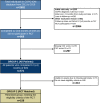Integrated Disease Management for Chronic Obstructive Pulmonary Disease in Primary Care, from the Controlled Trial to Clinical Program: A Cohort Study
- PMID: 35221683
- PMCID: PMC8866979
- DOI: 10.2147/COPD.S338851
Integrated Disease Management for Chronic Obstructive Pulmonary Disease in Primary Care, from the Controlled Trial to Clinical Program: A Cohort Study
Abstract
Purpose: Integrated disease management (IDM) for COPD in primary care has been primarily investigated under clinical trial conditions. We previously published a randomized controlled trial (RCT) where the IDM intervention improved quality of life (QoL) and exacerbation-related outcomes. In this study, we assess the same IDM intervention in a real-world evaluation and identify patient characteristics associated with improved outcomes.
Methods: This historical cohort study included patients enrolled for 12 (±3 months) in the Best Care COPD IDM program. The main outcome was a ≥3 point improvement in COPD assessment test (CAT). Secondary outcomes were COPD exacerbations requiring antibiotics and/or prednisone, unscheduled physician visits, emergency department visits and hospitalizations.
Results: Data for 571 patients (all patients) were included, 158 met the reference RCT eligibility (RCT matched). Improved QoL was observed in 43% (95% CI:38.9,47.2) of all patients, 47% (95% CI:39.5,55.6) of RCT matched vs 92% (95% CI:79.2,95.1) in the reference RCT intervention arm (n=72). Reductions (12 months IDM vs prior year) were observed in the proportion of patients experiencing exacerbation-related events (all patients): antibiotics/prednisone (-9.0%,95% CI:-13.9,-3.9); unscheduled physician (-33.1%,95% CI:-38.2,-27.9); emergency department (-9.6%,95% CI:-13.5,-5); and hospitalizations (-6.8%,95% CI:-10.0,-3.7). For the RCT matched group all reductions were comparable to the reference RCT intervention arm. The strongest predictors of improved QoL were baseline CAT, CAT≥20 vs CAT<10 (OR 15.6,95% CI:7.91,30.83), GOLD group B (OR 6.4,95% CI:3.42,11.85) and D (OR 5.64,95% CI:2.80,11.37) vs GOLD group A. Patients with prior antibiotic/prednisone use, FEV1 <30% predicted and GOLD group D were less likely to have no urgent health service utilization (OR 0.5,95% CI:0.30,0.68), (OR 0.2,95% CI:0.07,0.78) and (OR 0.3,95% CI:0.14,0.51), respectively.
Conclusion: Best Care COPD improved QoL and reduced exacerbation-related outcomes in a manner directionally similar to the RCT from which it emanated. Baseline QoL, exacerbation history, and GOLD category were identified as possible predictors of IDM impact and will inform future program development and resource allocation.
Keywords: COPD assessment test; chronic disease management; health service utilization; health status; quality of life.
© 2021 Hussey et al.
Conflict of interest statement
CL reports grants from Western University Professor of Health System Innovation; also reports personal fees for Advisory Board member for GlaxoSmithKline, AstraZeneca, Teva, Sanofi Genzyme and Valeo Pharma; and Research Grants from AstraZeneca; Honoraria or personal fees from AstraZeneca and GlaxoSmithKline, outside the submitted work. MF received honorarium from AstraZeneca outside the submitted work. The authors report no other conflicts of interests related to this study.
Figures



Similar articles
-
The impact of integrated disease management in high-risk COPD patients in primary care.NPJ Prim Care Respir Med. 2019 Mar 28;29(1):8. doi: 10.1038/s41533-019-0119-9. NPJ Prim Care Respir Med. 2019. PMID: 30923313 Free PMC article. Clinical Trial.
-
The impact of the duration of the integrated disease management program on COPD-related outcomes.Eur J Med Res. 2023 May 23;28(1):178. doi: 10.1186/s40001-023-01136-0. Eur J Med Res. 2023. PMID: 37221574 Free PMC article.
-
Does Working with a Health Coach Help Patients with COPD Improve Their Quality of Life and Breathe Easier? [Internet].Washington (DC): Patient-Centered Outcomes Research Institute (PCORI); 2019 Sep. Washington (DC): Patient-Centered Outcomes Research Institute (PCORI); 2019 Sep. PMID: 38620370 Free Books & Documents. Review.
-
Exploring characteristics of COPD patients with clinical improvement after integrated disease management or usual care: post-hoc analysis of the RECODE study.BMC Pulm Med. 2020 Jun 18;20(1):176. doi: 10.1186/s12890-020-01213-8. BMC Pulm Med. 2020. PMID: 32552784 Free PMC article. Clinical Trial.
-
Proton pump inhibitors for chronic obstructive pulmonary disease.Cochrane Database Syst Rev. 2020 Aug 25;8(8):CD013113. doi: 10.1002/14651858.CD013113.pub2. Cochrane Database Syst Rev. 2020. PMID: 32844430 Free PMC article.
Cited by
-
Estimating the Health and Economic Impact of Improved Management in Prevalent Chronic Obstructive Pulmonary Disease Populations in England, Germany, Canada, and Japan: A Modelling Study.Int J Chron Obstruct Pulmon Dis. 2023 Sep 27;18:2127-2146. doi: 10.2147/COPD.S416988. eCollection 2023. Int J Chron Obstruct Pulmon Dis. 2023. PMID: 37789931 Free PMC article.
-
Single-Inhaler Triple Therapy in Primary Care Across Europe: Expert Panel Consensus on the Consequences of Payer-Driven Access Rules and Call to Action.Int J Chron Obstruct Pulmon Dis. 2025 May 22;20:1595-1612. doi: 10.2147/COPD.S503726. eCollection 2025. Int J Chron Obstruct Pulmon Dis. 2025. PMID: 40433396 Free PMC article. Review.
-
Does uptake of specialty care affect HRQoL development in COPD patients beneficially? A difference-in-difference analysis linking claims and survey data.Eur J Health Econ. 2023 Dec;24(9):1561-1573. doi: 10.1007/s10198-022-01562-7. Epub 2023 Jan 13. Eur J Health Econ. 2023. PMID: 36637677 Free PMC article.
-
Quantifying sustained health system benefits of primary care-based integrated disease management for COPD: a 6-year interrupted time series study.Thorax. 2024 Jul 16;79(8):725-734. doi: 10.1136/thorax-2023-221211. Thorax. 2024. PMID: 38889973 Free PMC article.
-
Real-World Cost-Consequence Analysis of an Integrated Chronic Disease Management Program in Saskatchewan, Canada.Health Serv Insights. 2024 Jan 10;17:11786329231224621. doi: 10.1177/11786329231224621. eCollection 2024. Health Serv Insights. 2024. PMID: 38223214 Free PMC article.
References
-
- Global Initiative for Chronic Obstructive Lung Disease. Global Strategy for the Diagnosis, Management and Prevention of Chronic Obstructive Lung Disease. Report; 2022. Available from: https://goldcopd.org/wp-content/uploads/2021/11/GOLD-REPORT-2022-v1.0-12.... Accessed November, 2021.
-
- Bourbeau J, Bhutani M, Hernandez P, et al. Canadian Thoracic Society Clinical Practice Guideline on pharmacotherapy in patients with COPD – 2019 update of evidence. Can J Respir Crit Care Sleep Med. 2019;3(4):210–232. doi:10.1080/24745332.2019.1668652 - DOI
Publication types
MeSH terms
LinkOut - more resources
Full Text Sources
Medical
Miscellaneous

